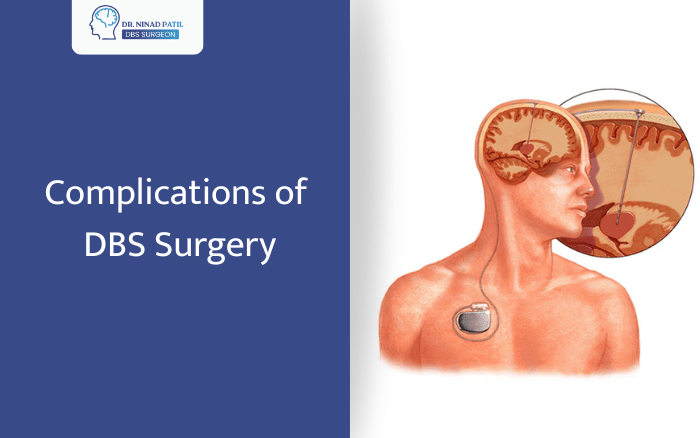If you or someone close to you is dealing with Parkinson’s disease, essential tremor, or dystonia, you’ve probably come across Deep Brain Stimulation (DBS). It’s often mentioned when medications stop working well.
DBS surgery can make a big difference in how people feel and function. But here’s the thing: it’s brain surgery. That means there are real risks you need to know about before making any decision.
This guide will walk you through the possible complications of DBS, what can go wrong, how often it happens, and what you can do to stay safe.
What Is DBS Surgery and Why Is It Done?
Deep Brain Stimulation involves placing thin wires (called electrodes) in certain areas of the brain. These wires are connected to a small device, usually placed under the skin near the chest, which sends tiny electrical signals to help manage symptoms.
DBS doesn’t cure any disease, but it can help control things like:
- Shaking (tremors)
- Stiffness
- Slow movement
- Uncontrollable body movements
Doctors usually recommend DBS for people with:
- Parkinson’s disease
- Essential tremor
- Dystonia
- In some cases, Obsessive-Compulsive Disorder (OCD) or epilepsy
It’s usually an option when medication isn’t helping enough or is causing too many side effects.
Short-Term Complications of DBS Surgery
Surgical Risks (During or Shortly After the Procedure)
Since DBS involves placing wires into the brain, it carries the same general risks as other brain surgeries. These include:
- Bleeding in the brain (intracranial hemorrhage): This is rare but serious. It can cause stroke-like symptoms or permanent damage.
- Stroke: Caused by damage to blood vessels during surgery.
- Infection: Can happen at the site of the implant or along the wires.
- Seizures: Some patients may experience seizures right after surgery, though this is uncommon.
Most of these issues show up within the first few days or weeks after the operation.
Hardware-Related Issues
The DBS system includes wires (leads), a battery-powered stimulator, and sometimes extension cables. Things that can go wrong here include:
- Lead misplacement: If the wire isn’t placed exactly where it needs to be, the results won’t be effective or may even cause unwanted effects.
- Device malfunction: The stimulator might stop working or deliver the wrong signals.
- Battery problems: Batteries wear out over time and may need replacement.
Long-Term Complications of DBS
Even months or years after surgery, some people experience side effects from the stimulation itself or from the hardware.
Stimulation Side Effects
The electrical signals can sometimes affect areas around the target zone, leading to:
- Slurred or soft speech
- Trouble with balance or walking
- Mood swings or sudden emotional changes
- Tingling or twitching in muscles
- Vision problems (like double vision)
These side effects often depend on where the electrodes are placed and how the settings are adjusted.
Cognitive and Emotional Changes
Some people report changes in how they think or feel, such as:
- Short-term memory problems
- Difficulty concentrating
- Feeling sad, anxious, or irritable
- Changes in motivation or behavior
These are less common but can be serious if not noticed early. Family members often spot these changes before the patient does.
How to Minimize the Risks of DBS Surgery
You can’t remove all risk, but you can reduce it with smart choices. Here’s what helps:
- Choose a well-trained, experienced surgeon who regularly performs DBS procedures
- Make sure your care team does detailed brain imaging (MRI or CT) before and during the operation
- Follow all post-op instructions—especially around wound care and device programming
- Don’t skip follow-up visits. Adjusting the stimulation settings is key to long-term success and fewer side effects.
When Should You Seek Medical Help After DBS?
After surgery, watch out for any of these signs:
- Fever or redness/swelling near the implant
- Severe or lasting headache
- Confusion, speech problems, or weakness
- Sudden changes in mood, memory, or behavior
- Worsening tremors or movement issues
These could mean infection, bleeding, or device problems and need quick attention.
Final Thoughts: Is DBS Worth the Risk?
For many people, the answer is yes. DBS has helped thousands of patients regain control over their movements and daily life when nothing else worked.
But it’s a personal decision. You’ll need to weigh the benefits against the risks, and that starts with having an honest talk with a doctor who truly understands DBS.
Ready to Talk to a DBS Surgeon?
If you’re considering DBS or just want a second opinion Dr. Ninad Patil, DBS surgeon in Pune, can help you understand your options. He has worked with many patients facing tough decisions about movement disorders, and can guide you through every step.
Reach out today to schedule a consultation and get clear, honest answers about whether DBS is right for you.
Frequently Asked Questions (FAQ)
1. Is DBS surgery high risk?
Not usually. Serious problems like bleeding or stroke are rare. Most people recover without major issues, especially when the surgery is done by someone experienced.
2. Can DBS cause personality changes?
Sometimes. A small number of patients report changes in mood or behavior. These can often be managed by adjusting the device settings.
3. What if the DBS device stops working?
Most device issues are fixable. The doctor can check and reprogram the device, or replace parts like the battery if needed.


